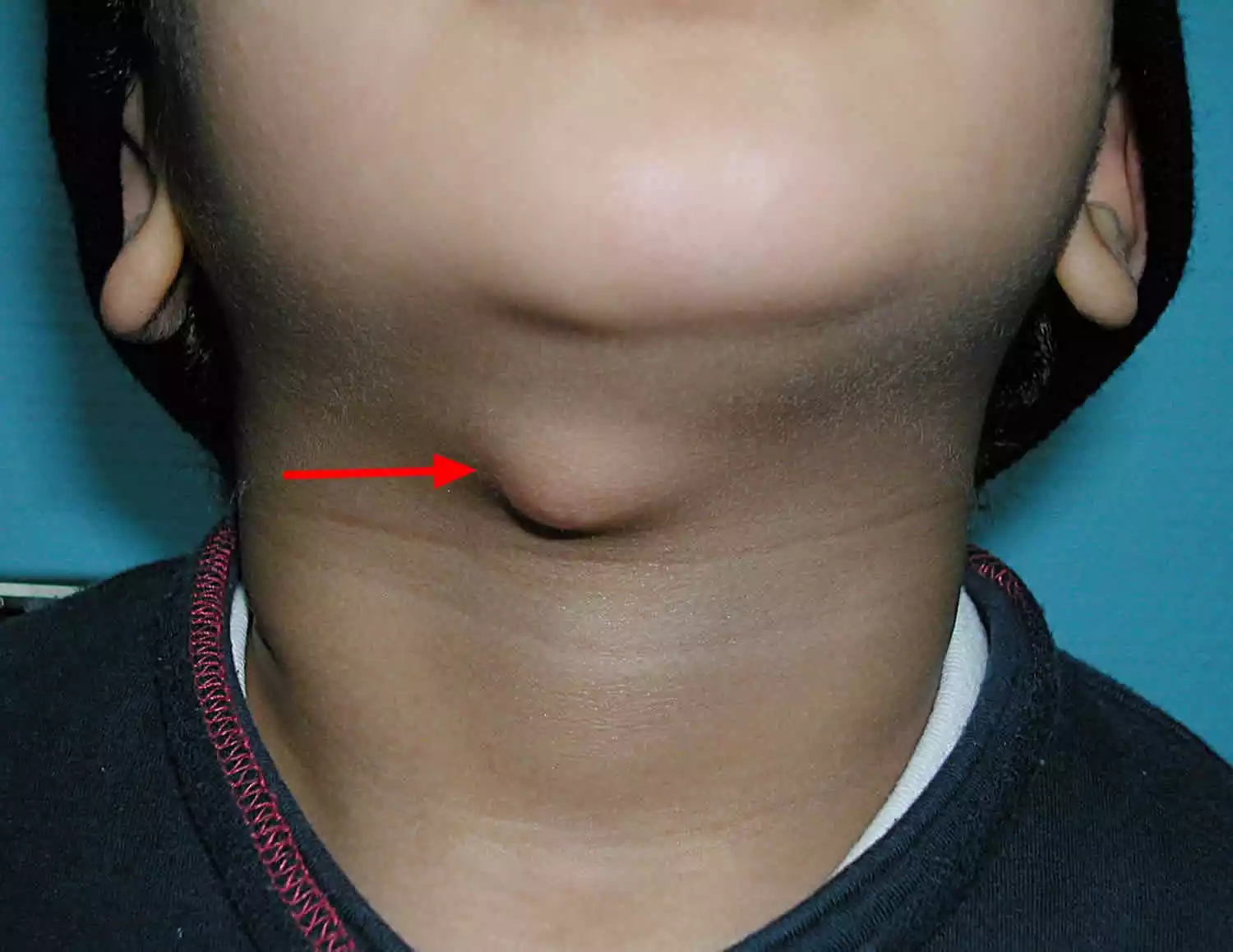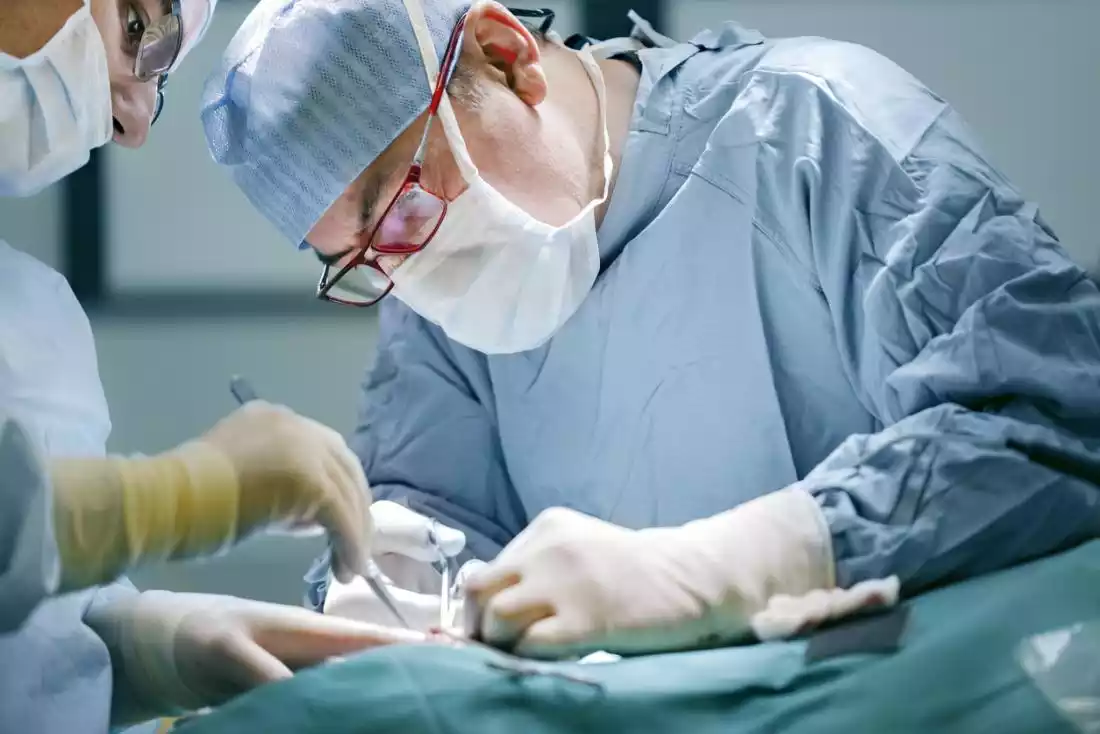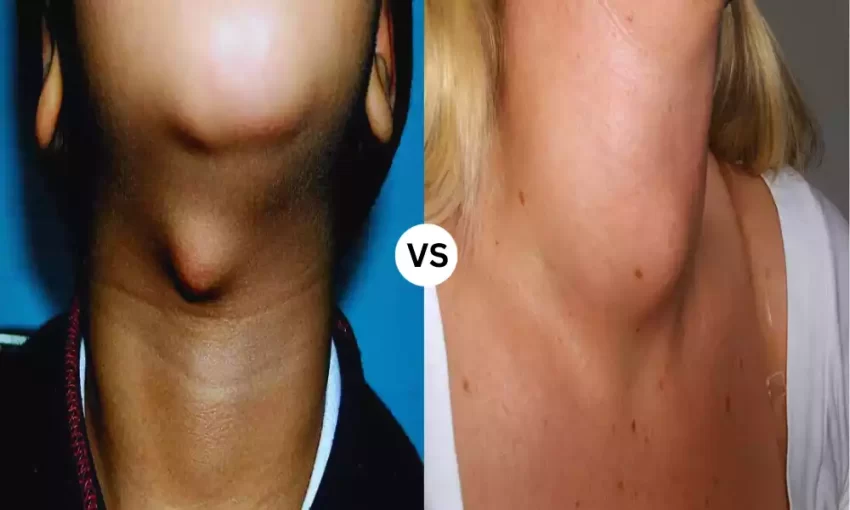Thyroglossal cysts are fluid-filled sacs arising from leftover thyroid tissue during fetal development, often appearing as a painless lump in the neck, typically midline. Surgical removal is the primary treatment to prevent infections or complications. Conversely, goiter is a thyroid gland enlargement due to iodine deficiency, inflammation, or thyroid disorders. This swelling leads to a visible neck protrusion, sometimes causing difficulty swallowing or breathing. Treatment includes medication, iodine supplements, or surgery, depending on the underlying cause.
What is Thyroglossal Cyst?
A thyroglossal cyst refers to a fluid-filled sac or pocket that develops in the neck during embryonic development. It arises from remnants of thyroid tissue left behind as the thyroid gland migrates from the base of the tongue to its usual location in the neck. These cysts typically manifest as painless lumps or swellings near the midline of the neck, just above the voice box, and can vary in size. Surgical removal is often necessary to prevent potential complications or infections.

Causes of Thyroglossal Cyst
Here are the causes of a thyroglossal cyst:
- Embryonic Remnants: During fetal development, the thyroid gland forms at the base of the tongue and then moves to its usual position in the neck. Sometimes, remnants of thyroid tissue can remain along the path of this migration, leading to the formation of a cyst.
- Incomplete Degeneration: If portions of the thyroid tissue fail to completely degenerate and instead persist along the path of migration, they can give rise to cysts later in life.
- Fluid Accumulation: Cysts can develop when these remnants of thyroid tissue accumulate fluid, leading to the formation of a sac or pocket in the neck.
- Genetic Predisposition: In some cases, genetic factors might contribute to the development of thyroglossal cysts, although this is less common.
Symptoms of Thyroglossal Cyst
Here are the symptoms associated with a thyroglossal cyst:
- Neck Lump: Presence of a painless, movable lump or swelling in the midline of the neck, usually just above the hyoid bone (a U-shaped bone in the neck).
- Difficulty Swallowing: In some cases, larger cysts might cause discomfort or difficulty swallowing, particularly when the cyst enlarges or becomes infected.
- Pain or Tenderness: If the cyst becomes infected or inflamed, it may lead to pain, redness, or tenderness in the affected area.
- Neck Movement Issues: Rarely, larger cysts might cause limited neck movement or discomfort, especially if the cyst is sizable or causing pressure on surrounding structures.
What is Goitre?
A goiter refers to the abnormal enlargement of the thyroid gland, causing swelling in the front part of the neck. This condition typically occurs due to various underlying factors, such as iodine deficiency, thyroid hormone imbalances (hypothyroidism or hyperthyroidism), inflammation, or nodules on the thyroid gland. The enlargement may cause visible swelling in the neck, sometimes leading to difficulty swallowing or breathing. Treatment depends on the cause and may involve medication, iodine supplements, or, in certain cases, surgical intervention.

Causes of Goitre
Here are the causes of goitre:
- Iodine Deficiency: A primary cause worldwide, inadequate intake of iodine, an essential nutrient for thyroid hormone production, can lead to the development of goitre.
- Thyroid Disorders: Conditions such as hypothyroidism (underactive thyroid), hyperthyroidism (overactive thyroid), Hashimoto’s disease, Graves’ disease, or thyroid nodules can cause goitre.
- Autoimmune Diseases: Certain autoimmune disorders, like Hashimoto’s thyroiditis or Graves’ disease, where the body’s immune system attacks the thyroid gland, might lead to goitre.
- Medications: Some medications, including lithium or certain anti-thyroid drugs, might contribute to goitre formation as a side effect.
- Genetic Factors: In some cases, genetic predisposition or family history of thyroid disorders can increase the likelihood of developing goitre.
Symptoms of Goitre
Here are the symptoms associated with goitre:
- Visible Neck Swelling: Enlargement of the thyroid gland in the neck, leading to a visible swelling or lump in the front of the neck.
- Difficulty Swallowing: Depending on the size and extent of the goitre, individuals may experience difficulty swallowing or a sensation of pressure in the throat.
- Hoarseness or Voice Changes: Pressure from an enlarged thyroid gland might cause changes in voice quality or hoarseness.
- Difficulty Breathing: Large goitres can put pressure on the windpipe (trachea) or esophagus, leading to breathing difficulties or a feeling of choking.
- Coughing or Wheezing: In some cases, particularly when the goitre compresses nearby structures, persistent coughing or wheezing might occur.
- Thyroid Function Changes: Depending on the underlying cause, individuals might exhibit symptoms of an overactive or underactive thyroid gland, such as weight changes, fatigue, heat or cold intolerance, and mood disturbances.
Comparison table of Thyroglossal Cyst and Goitre
Here’s a comparison table highlighting key differences between thyroglossal cyst and goitre:
| Feature | Thyroglossal Cyst | Goitre |
|---|---|---|
| Definition | Fluid-filled sac from thyroid tissue remnants during embryonic development | Enlargement of the thyroid gland in the neck |
| Location | Typically midline of the neck, just above the voice box | Front part of the neck, centered around the thyroid gland |
| Cause | Embryonic remnants, incomplete tissue degeneration | Iodine deficiency, thyroid disorders, autoimmune conditions, medications |
| Symptoms | Neck lump, difficulty swallowing, pain/tenderness (if infected) | Visible neck swelling, difficulty swallowing, hoarseness, breathing difficulties |
| Age Group | More common in individuals under 20 years old | Can affect individuals of any age, more common in older adults |
| Gender Predilection | Slightly higher incidence in males | More prevalent in females |
| Risk Factors | Age, gender, incomplete removal, possible genetic factors | Iodine deficiency, gender (female), age, family history, autoimmune diseases, certain medications |
| Treatment | Surgical removal, especially if causing symptoms or complications | Depends on underlying cause: medication, iodine supplements, or surgery |
| Complications | Infection, recurrence if removal is incomplete | Breathing difficulties, swallowing issues, thyroid dysfunction |
This table highlights the distinctive features, causes, symptoms, and other characteristics of both thyroglossal cyst and goitre, aiding in their differentiation and understanding.
What are the similarities between Thyroglossal Cyst and Goitre?
While thyroglossal cysts and goitres are distinct conditions with differing causes and characteristics, they do share a few similarities:
- Neck Presence: Both conditions involve abnormalities or swellings in the neck area.
- Potential Impact on Swallowing: Depending on their size and location, both a thyroglossal cyst and a goitre can potentially lead to difficulty swallowing.
- Visible or Palpable Lump: Both can present as palpable or visible lumps in the neck, although their locations differ (thyroglossal cysts are typically midline, while goitres are centered around the thyroid gland).
- Treatment Options: Surgical intervention might be necessary for both conditions, especially if they cause symptoms or complications. Surgical removal is a common treatment approach for both thyroglossal cysts and goitres.
- Complications: Infection is a potential complication for both conditions. If a thyroglossal cyst becomes infected, it can lead to pain and inflammation. Similarly, goitres might develop complications related to their size, causing difficulties with breathing or swallowing.
The causes, underlying mechanisms, and specific characteristics of thyroglossal cysts and goitres differ significantly. Therefore, accurate diagnosis and appropriate treatment are essential for managing each condition effectively.
Treatment Options for Thyroglossal Cysts
The primary treatment for thyroglossal cysts is surgical removal, typically performed by an ear, nose, and throat (ENT) surgeon or a head and neck surgeon. The surgical procedure used to remove a thyroglossal cyst is called the Sistrunk procedure.

Here are the key steps involved in the treatment:
- Sistrunk Procedure: This surgery involves removing the thyroglossal cyst, the cystic tract, and a portion of the hyoid bone (a U-shaped bone in the neck) to prevent recurrence. The procedure aims to completely excise the cyst and its connection to the base of the tongue.
- General Anesthesia: The surgery is performed under general anesthesia, ensuring the patient is unconscious and doesn’t feel any pain during the procedure.
- Incision and Removal: The surgeon makes an incision in the midline of the neck to access the cyst and carefully removes it along with the tract that connects it to the base of the tongue. A part of the hyoid bone may also be removed.
- Closure: Once the cyst and associated structures are removed, the incision is closed with stitches, and the wound is dressed.
- Recovery: Recovery time is usually relatively quick. Pain medication might be prescribed to manage any discomfort post-surgery. Patients are typically advised to avoid strenuous activities for a few weeks following the procedure.
- Follow-up: Regular follow-up appointments with the surgeon are essential to monitor healing and ensure there are no signs of recurrence.
Impact on Daily Life and Activities
Thyroglossal cysts, depending on their size and whether they’re causing symptoms, might impact daily life and activities in various ways:
- Discomfort: Larger or infected cysts can cause discomfort, pain, or tenderness in the neck, affecting one’s comfort during daily activities.
- Swallowing and Eating: If the cyst is sizable or causing pressure on the throat, it might lead to difficulty swallowing or discomfort while eating.
- Breathing: Rarely, particularly in cases of significant cyst enlargement, individuals might experience breathing difficulties due to pressure on the airway.
- Cosmetic Concerns: Visible neck swelling from the cyst might lead to self-consciousness or concerns about appearance, potentially impacting social interactions.
- Activity Limitations: In severe cases, if the cyst significantly interferes with breathing or swallowing, it might limit certain physical activities or exercise.
- Pain or Discomfort during Movement: Neck movements might be restricted or uncomfortable if the cyst is large or causing pressure on surrounding structures.
Seeking medical attention and discussing treatment options with a healthcare professional is crucial if a thyroglossal cyst is causing discomfort or impacting daily life. Surgical removal is often recommended to alleviate symptoms and prevent potential complications, allowing individuals to resume their regular activities without these hindrances.
Preventive Measures for Thyroglossal Cysts and Goitre
Preventive measures for thyroglossal cysts and goitre primarily focus on addressing underlying causes and maintaining thyroid health. Here are some preventive measures:
Preventive Measures for Thyroglossal Cysts:
- Early Diagnosis and Treatment: Prompt evaluation of any neck swelling or lump is essential. Seeking medical attention for proper diagnosis and timely treatment can prevent complications or cyst enlargement.
- Complete Surgical Removal: If diagnosed with a thyroglossal cyst, ensuring complete surgical removal with the Sistrunk procedure reduces the chances of recurrence.
- Regular Follow-ups: After surgical removal, attending follow-up appointments with the healthcare provider is important to monitor healing and detect any signs of recurrence early.
Preventive Measures for Goitre:
- Iodine Intake: Consuming sufficient dietary iodine, obtained from iodized salt, seafood, dairy products, and certain vegetables, helps prevent iodine deficiency, a leading cause of goitre in regions with low iodine content in the diet.
- Balanced Diet: A well-balanced diet rich in nutrients, including selenium and zinc, is beneficial for overall thyroid health.
- Avoiding Goitrogenic Foods: Some foods like cabbage, broccoli, and soy might interfere with thyroid function. Moderating the intake of these foods might be helpful.
- Thyroid Health Monitoring: Regular thyroid function tests and check-ups can help detect and manage any thyroid abnormalities or disorders early.
- Medication Adherence: If diagnosed with a thyroid disorder like hypothyroidism or hyperthyroidism, following prescribed medications and treatment plans as directed by a healthcare professional is crucial for managing thyroid health and preventing goitre complications.
Consulting with a healthcare provider for personalized advice and guidance tailored to individual health needs is essential for implementing effective preventive measures against thyroglossal cysts and goitre.
Research and Future Perspectives
Research into thyroglossal cysts and goitre primarily focused on several key areas:
Thyroglossal Cysts:
- Improved Surgical Techniques: Ongoing research aims to refine surgical procedures for thyroglossal cyst removal, focusing on minimizing recurrence rates and reducing post-operative complications.
- Genetic Studies: Investigating the genetic factors contributing to the development of thyroglossal cysts might provide insights into why some individuals are more predisposed to these cysts, potentially leading to better preventive strategies.
- Non-Surgical Treatments: Exploring alternative treatment options, such as minimally invasive procedures or medications, to manage small asymptomatic cysts without resorting to surgery.
Goitre:
- Iodine Supplementation Studies: Continued research aims to assess the effectiveness of iodine supplementation programs in regions with iodine-deficient populations to prevent and manage goitre.
- Autoimmune Thyroid Disorders: Further understanding of the underlying mechanisms of autoimmune thyroid diseases, such as Hashimoto’s thyroiditis and Graves’ disease, may lead to targeted therapies to prevent goitre development in affected individuals.
- Personalized Medicine Approaches: Research into genetic markers and molecular pathways associated with goitre aims to develop personalized treatment approaches tailored to individual patients based on their specific genetic and molecular profiles.
Future perspectives in these areas may involve advancements in precision medicine, molecular therapies, and innovative surgical techniques aimed at improving outcomes, reducing recurrence rates, and enhancing overall management strategies for both thyroglossal cysts and goitre.
The field of medical research continually evolves, and there might have been advancements or new findings beyond my last update. It’s advisable to consult current medical literature or healthcare professionals for the latest information on research and future perspectives regarding these conditions.
Summary
Thyroglossal cysts are remnants from fetal thyroid development, often requiring surgical removal. Goitre, an enlarged thyroid gland, results from various factors like iodine deficiency or thyroid disorders, managed with medication or surgery. Ongoing research aims to improve treatments and understand genetic influences for better management strategies.

